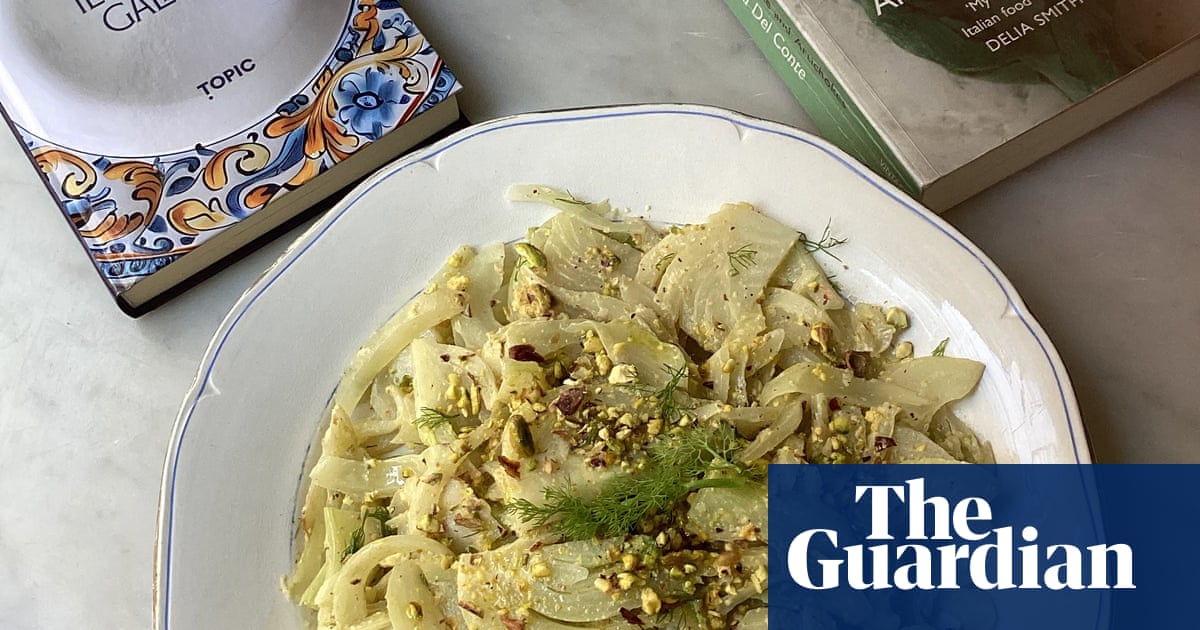Iam looking after a pile of cookbooks at the moment. They belonged to thelate cook and teacher Carla Tomasi, who wanted them to be useful, so gave them to theLatteria cooking studio. However, until the studio has more shelves, I have 15 of Carla’s 60 books sitting by my desk. They are a well-loved pile, but five in particular stand out as having been used and used. The first isDan Lepard’s Short and Sweet, which, thanks to grey duct tape, is just about holding together, and the second isThane Prince’s Perfect Preserves, also duct-taped. The third is a 1985 edition ofClaudia Roden’s A Book of Middle Eastern Food, the fourthElisabeth Luard’s 1991 The Flavours of Andalusiaand the fifthAnna del Conte’s 1987 Gastronomy of Italy, all of which are missing at least one cover, have loose pages and bite marks (dogs?), are covered in brown paper and have their titles written on them with marker pen.
As anyone who worked with or was taught by Carla will know, she was a cooking snowball: always gathering. Also, that she was immensely generous in her acknowledgements, carefully noting the place, book or person from whom she had gathered it. Del Conte, in particular, was someone who came up constantly, and Carla referred to Gastronomy of Italy, which she bought a few years after arriving in London, as a life-changing book that taught her about the country she had left.
I have been imagining myself as 35-year-old Carla, sitting at her kitchen table just off Tottenham Court Road, making notes on the map at the beginning of the book. Later, when Carla was giving lessons upstairs atBooks for Cooks, she would meet Anna. Years after that, Carla and I would make Anna’s fennel with pistachio, lemon and anchovy sauce for a class at Latteria Studio. Anna had learned the recipe from the 18th-century writer Vincenzo Corrado, to whom she refers as one of her favourite cookery writers and notes that the dish “leaves you delighted yet puzzled as to how such an unlikely combination of flavours could blend with such complete harmony”. Carla agreed – and I did, too – and here is the recipe.
Corrado’s concise recipe includes no mention of resting, or indeed any serving suggestions, for that matter, but he was writing in 1773 and for experienced cooks preparing extravagant, carefully controlled feasts. Del Conte, on the other hand, writing in 1986, suggests covering and resting the dish in the fridge for 24 hours, then bringing it back to room temperature before serving.
I took the opportunity to taste at various stages and two stood out: about an hour after mixing, when the dressing has started to sink in but the lemon is still fresh; and after 24 hours, by which time the dressing and fennel are inseparable and the dish sits halfway between a dressed vegetable and a relish. Complete harmony served with a few crushed pistachios, more olive oil and the reserved fennel fronds, plus roast chicken, grilled fish, pork chops or hard-boiled eggs.
Serves4
3-4fennel bulbs(about 700g in total)300ml dry white wine2 bay leaves2½cm cinnamon stick8 whole peppercorns30g pistachios, skin rubbed away as much as possible, plus extra to finish3 anchovy fillets1 tsp sugar4 tbsp olive oil,plus extra to serve2 tsp white-wine vinegar2-4 tbsp lemon juice, plus finely grated lemon zest to taste
Trim the fennel and remove and discard the outer layer if bruised or particularly thick; save any frilly fronds. Cut the bulbs first into quarters and then into slim wedges (don’t worry if they fall apart a bit).
Put the wine, bay leaves, cinnamon and peppercorns in a pan, add the fennel and enough water just to cover the fennel, then bring to a boil. Reduce to a simmer and cook for about eight minutes, until the fennel is just tender. Drain and put the fennel in a shallow dish.
For the sauce, and working in either a mortar or food processor, grind or blend the pistachios, anchovy, sugar, olive oil and white-wine vinegar to a thick paste. Add the lemon juice, tasting as you go, and the lemon zest to your liking. Pour the dressing over the fennel, toss well, then rest for 20 minutes to 24 hours (for anything over two hours, cover and keep in fridge).
Before serving, let the dish return to room temperature, then finish with a few crushed pistachios, a bit more olive oil and the reserved fennel fronds, if you like.
